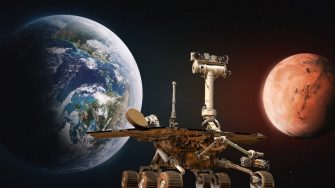
UNSW is set to position itself at the very forefront of space robotics environmental testing in Australia after securing a significant ARC Linkage Infrastructure, Equipment and Facilities (LIEF) grant.
Nearly $2.1m was awarded by ARC for UNSW to set up a Space Resources Environmental Analogue Facility (SREAF) in collaboration with Queensland University of Technology, which will allow researchers to test equipment in realistic moon, Mars and asteroid conditions.
The new facility will consist of a Dirty Thermal Vacuum Chamber, an indoor Moon Yard, and a Material Characterisation Frame at UNSW, plus a Lunar Testbed at QUT.
The Dirty Thermal Vacuum Chamber replicates temperatures and pressures on deep space objects, while not having the ultra-clean requirement of a more usual spacecraft facility.
The Moon Yard simulates the surface of Earth’s natural satellite, allowing technologies to be tested and then certified for operation on the moon, for example in the Australian Space Agency’s ‘Moon to Mars’ program.
Mobility tests on various robotics can be performed at reduced gravity (using a crane to reduce the robot's apparent weight). Slope, rock and cooperative tests can be run on realistic surfaces.
The Material Characterisation Frame will allow testing of materials, most particularly rocks, at extreme temperatures (both high and low).
QUT’s Lunar Testbed is a large robotics facility for autonomous navigation and operation of multiple rovers on simulated lunar surfaces.
Best in Australia
Professor Andrew Dempster, director of the Australian Centre for Space Engineering Research (ACSER) at UNSW, led the SREAF bid and said the grant came at a critical time to support Australia’s space research.
“This is a great boost for the collaboration between UNSW and QUT. QUT is an honest and trusted partner and we have worked together on a range of projects and the facilities themselves are a huge leap forward for space resources research in Australia,” Prof. Dempster said.
“This facility will be the best place in Australia to perform space robotics environmental testing and testing of materials such as regolith – loose deposits covering the surface of the moon and asteroids – in deep space environmental conditions. This aligns closely with the Australian Space Agency’s Moon to Mars program.
“The facilities of SREAF will allow the teams at UNSW and QUT to develop and test technology for future missions to the moon and later to Mars in a comprehensive way that is unique in Australia, and would be prohibitive to do in a single facility.
“Equipment such as rovers or components can be first tested in a vacuum and in relevant pressures and temperatures, in small-scale space, and later with simulated lower gravity in larger scale of navigation (or vice versa).”
The funding will also allow ACSER and UNSW’s School of Minerals & Energy Resources Engineering to continue work commenced under a Australia-Korea Foundation grant which includes visits to the Korea Institute of Civil Engineering and Building Technology to use their Dirty Thermal Vacuum Chamber.
It also comes after the ARC awarded a LIEF grant of $690,000 for the Spacecraft Innovation Laboratory, which includes a Satellite Bus, Groundstation, 3-axis Helmoltz Coil, Electrodynamic Shaker, Solar Simulator, Clean Environment, Electromagnetic Anechoic Chamber, led by ACSER.
UNSW plans to house both sets of LIEF equipment at a single location, with the ambition of plugging into the national and state space testing infrastructure.
